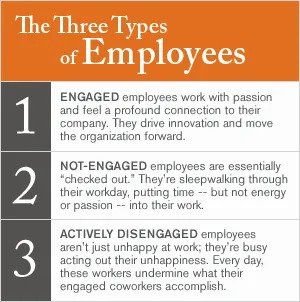In a recent webinar on Emotional Intelligence, the following statistic was dropped in: “Employee disengagement costs $450 billion in lost productivity.” That caught my attention!
So, being interested in such things, I went to the data. According to Gallup, an alarming 70% of Americans aren’t working to their full potential. But really, what does that mean?
Gallup created three different types of employees and have been using this metric to track employee engagement for the last two decades (their chart is on the right):
1. Engaged employees – essentially these are the folks who are enthusiastic about, and committed to, their workplace
2. Not engaged employees – these are the people who show up, do the minimal amount to get by, and collect a paycheck
3. Actively disengaged employees – these folks are dangerous. They undermine others, are actively disruptive, and take up an enormous amount of management and HR time.
The statistic from Gallup about the costs of lost productivity ($450-$550 billion annually) is only WHAT THIS LAST GROUP COSTS. It doesn’t include what we’re losing in the middle group of people who are “phoning it in.”
Unfortunately, the trends have remained essentially stagnant over the last 18 years (as long as Gallup has been tracking this statistic). But there is some good news.


Good News: The trend is finally inching up…slowly but surely!
March 2016, Gallup reported that 16.5 % of workers (down from 18% in 2012) were “actively disengaged.” In June 2018, the number had dropped to 13% – the lowest in their 18 years of data. Still, on average, 17% of U.S. workers have been actively disengaged over the 18 years of tracking.
Still, when I think about these folks who are not engaged, I am reminded of the question I heard recently, “Who among us said, ‘when I grow up I want to do something with borderline competency that I don’t really care about just to make enough money to survive’?”
With disengagement costing us so much – in bottom line lost productivity, in increasingly high turn-over costs and in the costs to our collective joie-de-vivre – what are so strategies on how to foster it?
What happens when employees are engaged? Increased:

(Velcro as in a tight connection between organization and employees)
3 Strategies for increasing engagement:
1) Move from annual reviews to positive continuous performance management
Annual reviews are a thing of the past. 75-85% of organizations are making the change to continuous performance management according to Deloitte HC Trends. Brain science tells us that focusing on people’s weaknesses and failures does not create long-term behavior change. What does? Focusing on growth opportunities and strengths – at the moment teaching opportunities arise – empowers agility and long-lasting improvements.
2) Focus on mindsets
 After decades of research, world-renowned Stanford University psychologist Carol S. Dweck, Ph.D., discovered a simple but groundbreaking idea: the power of mindset. A mindset is a series of self-perceptions or beliefs people hold about themselves. These determine behavior, outlook and mental attitude. Growth vs. Fixed mindset is the most commonly understood dichotomy. Other opposed mindset are Open and Closed mindsets, prevention and promotion mindsets, and inward and outward mindsets.
After decades of research, world-renowned Stanford University psychologist Carol S. Dweck, Ph.D., discovered a simple but groundbreaking idea: the power of mindset. A mindset is a series of self-perceptions or beliefs people hold about themselves. These determine behavior, outlook and mental attitude. Growth vs. Fixed mindset is the most commonly understood dichotomy. Other opposed mindset are Open and Closed mindsets, prevention and promotion mindsets, and inward and outward mindsets.
3) Create an organizational culture/climate where people can thrive, with hallmarks of respect, civility, feelings of belonging, autonomy and accountability
Science has taught us that, when our brain is on high alert, it’s very difficult for people to be creative, productive or engaged. We get to learn how to engage the reward center and calm the threat centers of our brains. We do this by creating a sense of belonging with each employee (that requires more than free lunches or interesting work perks). By focusing on employees’ value, providing information to reduce uncertainty, creating autonomy, increasing relatedness, and ensuring fairness. Real change occurs at the local level and it sticks only with a commitment and authentic top from the top.
Janine Hamner Holman is the CEO of J&J Consulting Group. She has more than 30 years’ experience in organizational development and change management built through working with both Fortune 200 companies and national nonprofit organizations. She spent 10 years studying brain science and developed curriculum to help great organizations create thriving workplaces with engaged, high-performing teams, led by dynamic leaders with whom everyone wants to work. She is especially focused on assisting organizations to become an employer of choice to attract and retain superior talent in the coming era of increased labor competition.






